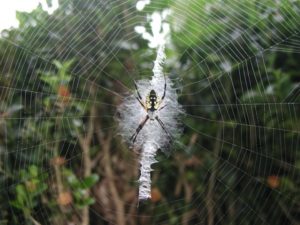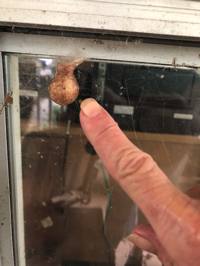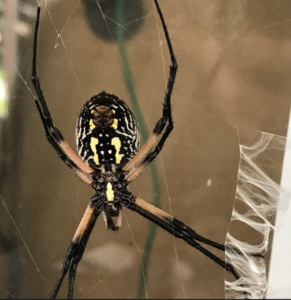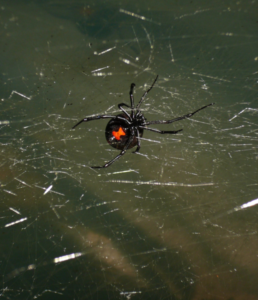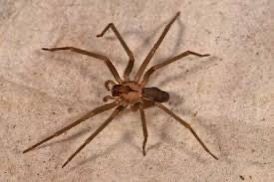Spiders
Before we start, let’s get one fact straight: spiders are not insects; they are arachnids; in fact, many spiders eat harmful insects.
Spiders seldom bite. Just like their hated counterparts in the reptile world (snakes), spiders get a bum rap because people are afraid of them. Trust me, spiders have no wish to get into a fight with humans. All they want is to be left alone. We have spiders living all over our farm, and we have never sprayed for them. It’s one of the reasons that in twenty plus years, we have never had to worry about roaches or other pests; I’m convinced the spiders are taking care of them. We find spiders in the yard (especially by the barn), under the porch (a favorite spot to lay eggs), and lots of them in a narrow corridor between the trees where the property begins to be more heavily wooded (picture below). They seem to catch a lot of prey there, but I have yet to see a human caught in the web.
Most spiders are not only harmless, they’re beneficial in many ways. Spiders eat other insects that many consider undesireable: mosquitoes, roaches, flys, and even other spiders. Below are two pictures: one of a mother argiope spider guarding her egg sac, and the second of the egg sac itself.
Baby spiders are protected within brown, papery egg sacs that the mother guards fiercely. Each sac has anywhere from a few hundred to more than a thousand eggs. The mother spider puts her babies (sac) on the side of her web, and she keeps it close to her so she can guard it.
Aside from being harmless and beautiful, the argiope spider is a master at weaving a web. Her webs are complex, intricate, and designed as if by an engineer. Take a close look at the web between the trees. She can walk (or run) along any of those threads just like we’d run on a road. And the webs are amazingly strong.
Spider silk is also incredibly strong and flexible. Some silk is up to five times as strong as the same amount of steel and twice as strong as the same amount of Kevlar. Scientists are working right now to try to emulate a spider’s silk-weaving abilities to make better bulletproof vests.
There is a history of silk for just such use. Mongolian warriors in the time of Gengis Khan were said to have used silk vests to protect themselves. It supposedly stopped arrows as well as the chain mail worn by Europeans, but it was much lighter and allowed the warriors greater flexibility.
While it’s a mystery to scientists exactly how a spider forms silk, the weaving process itself isn’t a mystery. Spiders have tiny spinnerettes on the bottom side of their abdomen, near the back. These spinnerettes spit out silk amazingly fast. You can look here for a video of a crablike orb weaver in the process of spinning her web.
Also, if you look closely at the picture below, you’ll see a circular brown spot on the spider’s abdomen near the back. That’s a picture of the underside of the argiope which is by our window. By the way, I don’t know what the normal procedure is, but that mother spider has been in the same spot for more than two weeks now, continually guarding that egg sac. We’ve looked early in the morning, midday, and nighttime, but she is always there.
Argiopes are not dangerous. Even if you inadvertantly disturb her nest, and she bites, it’s no worse than a bee sting. If left undisturbed, the spider will not bother humans.
Below is an electron microscope image of a spider’s spinnerettes, courtesy of How Stuff Works
By the way, the next time you come across a spider, you might consider just leaving it alone. It will likely go on its way the moment you leave. And I guarantee it won’t chase after you. And if you see a spider inside your house, consider letting it go about its business. It will probably go a long way to cleansing your house of pests.
If you are still afraid of being bitten, don’t be. There are only two spiders I would suggest being cautious about: the black widow and the brown recluse. Pictures of both are below. Of the two, I’d say the brown recluse presents more danger, but you should be cautious of both. Here is a description of a brown recluse: a brown recluse has a sandy-brown body with a darker marking at its center. They may also be dark brown or even yellowish.

